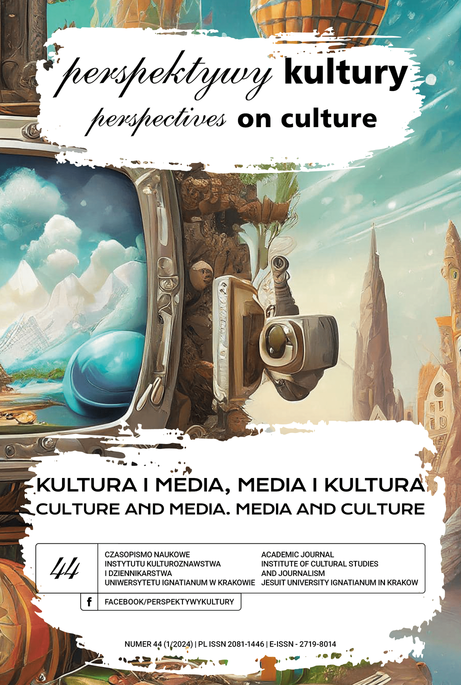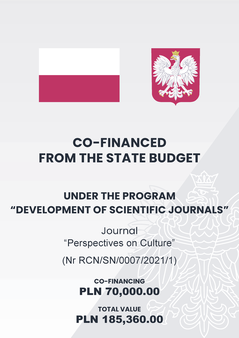Resilient Cities and Cultural Sector
Abstract
Resilience, understood as the ability to respond adequately to shocks, disruptions and disturbances, i.e. the capacity to sustain or revert to the assumed functioning or swiftly adapt to the situation through transformation is a crucial characteristic of the contemporary city. To appropriately confront contemporary challenges, cities should leverage available endogenous resources. One of them, still insufficiently acknowledged, is the cultural sector and its activities. The aim of the article is to show that culture can serve as a significant building component in fostering urban resilience. Drawing upon extensive literature review, examples of employing culture to foster social, economic, and environmental resilience are presented. They confirm the cultural potential that cities possess in harnessing culture to bolster their resilience.
References
Aldrich, D.P. (2015). Social capital in post disaster recovery: strong net-works and communities create a resilient east Asian community. W: D.P. Aldrich, S. Oum i Y. Sawada (red.), Resilience and recovery in Asian disasters. Tokyo: Springer Japan, 19–34.
Areso, I. (2017). Bilbao’s Strategic Evolution: the Metamorphosis of the Industrial City. MAS Context, Issue 30–31 Bilbao. Pozyskano z: https://mascontext.com/issues/bilbao/bilbaos-strategic-evolution-the-metamorphosis -of-the-industrial-city.
Ashworth, G.J. (1993). Heritage planning: an approach to managing his-toric cities. W: Z. Zuziak (red.), Managing Historic Cities. Kraków: In-ternational Cultural Centre, 27–53.
Baborska-Narożny, M. (2011). Projektowanie uwzględniające rozbiórkę. Kształtowanie nieuniknionego. Czasopismo Techniczne, t. 108, nr 4-A/2.
Bridge, G. i Watson, S. (2003). A Companion to the City. Malden–Oxford–Victoria–Berlin: Blackwell Publishing.
Council of European Union (2014). Conclusions on cultural heritage as a strategic resource for a sustainable Europe. Brussels: Education Youth, Culture and Sport Council meeting, Council of European Union. Pozyskano z: https://eur-lex.europa.eu/legal-content/EN/TXT/?uri=CELEX%3A52014XG0614%2808%29.
Drakulić, S. (1993). Falling Down: A Mostar Bridge Elegy. The New Repub-lic, 13 grudnia 1993.
Drobniak, A. (2014). Method of assessing the resilience of a city. W: A. Drobniak (red.), Urban Resilience Concept and Post-Industrial Cities in Europe. Katowice: University of Economics in Katowice, 49–82.
Drobniak, A., Cyran, R., Plac, K., Rykała, P. i Szymańska, J. (red.). (2021). Rezyliencja miast i regionów Europy Środkowej w kontekście hybrydy-zacji rozwoju. Katowice: Wydawnictwo Uniwersytetu Ekonomicznego w Katowicach.
Egusquiza, A., Lückerath, D., Zorita, S., Silverton, S., Garcia, G., Servera, E., Bonazza, A., Garcia, I. i Kalis, A. (2023). Paving the Way for Climate Neutral and Resilient Historic Districts. Open Research Europe, nr 3, 42. DOI: 10.12688/openreseurope.15392.1.
Figueiredo, L., Honiden, T. i Schumann, A. (2018). Indicators for Resilient Cities. OECD Regional Development Working Papers, nr 02. DOI: 10.1787/6f1f6065-en.
Gorzelak, G. (2008). Miasto jako przedmiot badania ekonomii. W: B. Ja-łowiecki (red.), Miasto jako przedmiot badań naukowych na początku XXI wieku. Warszawa: Wydawnictwo Naukowe Scholar, 89–104.
Goss, K. (2001). Better Together. The report of Saguaro Seminar: Civic Engagement in America. Saguaro Seminar: Civic Engagement in Amer-ica, John F. Kennedy School of Government. Cambridge, MA: Harvard University.
GUS (2023). Przemysły kultury i kreatywne w 2021 r. Informacja sygnalna. Pozyskano z: https://stat.gov.pl/obszary-tematyczne/kultura-turystyka-sport/kultura/przemysly-kultury-i-kreatywne-w-2021-roku,21,5.html.
Holling, C.S. (1973). Resilience and stability of ecological systems. Annual Review of Ecology and Systematics, nr 4, 1–23. DOI: 10.1146/annurev.es.04.110173.000245.
Holtorf, C. (2018). Embracing change: How cultural resilience is increased through cultural heritage. World Archaeology, nr 50(4), 639–650. DOI: 10.1080/00438243.2018.1510340.
Jigyasu, R. i in. (2013). Heritage and Resilience. Issues and Opportunities for Reducing Disaster Risks. 4th Session of the Global Platform for Dis-aster Risk Reduction, 19–23 May 2013 in Geneva, Switzerland. UNISDR.
Kamran, M. (2022). Role of cultural heritage in promoting the resilience of linear/critical infrastructure system with the enhancement of eco-nomic dimension of resilience: a critical review. International Journal of Construction Management, nr 22(7), 1345–1354.
Keck, M. i Sakdapolrak, P. (2013). What is social resilience? Lessons learned and ways forward. Erdkunde, nr 67(1), 5–19. DOI: 10.3112/erdkunde.2013.01.02.
Klamer, A. (1996). The Value of Culture: On the Relationship between Economics and Arts. Amsterdam: Amsterdam University Press.
Kłoskowska, A. (2005). Kultura masowa. Krytyka i obrona. Warszawa: PWN.
Komisja Europejska (2014). Komunikat Komisji do Parlamentu Europej-skiego, Rady, Europejskiego Komitetu Ekonomiczno-Społecznego i Komitetu Regionów. Ku zintegrowanemu podejściu do dziedzictwa kulturowego w Europie, COM(2014) 477 final. Bruksela: Komisja Euro-pejska. Pozyskano z: https://eur-lex.europa.eu/legal-content/PL/ALL/?uri=CELEX%3A52014 DC0477.
Kroeber, A.L. i Kluckhohn, C. (1952). Culture: A Critical Review of Concepts and Definitions. Cambridge, MA: Harvard University. Pozyskano z: https://iiif.lib.harvard.edu/manifests/view/drs:427692955$9i (dostęp: 24.09.2023).
Lewandowski, P., Mućk, J. i Skrok, Ł. (2010). Znaczenie gospodarcze sek-tora kultury. Wstęp do analizy problemu. Raport końcowy. Warszawa: Instytut Badań Strukturalnych.
Maik, W. (2008). Ewolucje teoretyczno-metodologiczne studiów miejskich w świetle zmieniających się konceptualizacji miasta. W: J.J. Parysek i T. Stryjakiewicz (red.), Region społeczno-ekonomiczny i rozwój regio-nalny. Poznań: Bogucki Wydawnictwo Naukowe, 77–90.
Martin, R. i Sunley, P. (2020). Regional Economic Resilience: Evolution and Evaluation. W: G. Bristow i A. Healy (red.), Handbook on Regional Economic Resilience. Cheltenham: Edward Elgar, 10–35.
Matarasso, F. (2001). Culture, Economics & Development. W: F. Matarasso (red.), Recognising Culture. A Series of Briefing Papers on Culture and Development. London: Comedia-Department of Canadian Heritage-UNESCO.
Meerow, S., Newell, J.P. i Stults, M. (2016). Defining Urban Resilience: A Review. Landscape and Urban Planning, nr 147, 38–49. DOI: 10.1016/j.landurbplan.2015.11.011.
Mierzejewska, L. i Wdowicka, M. (2018). City Resilience vs. Resilient City: Terminological Intricacies and Concept Inaccuracies. Quaestiones Ge-ographicae, nr 37(2), 7–15. DOI: 10.2478/quageo-2018-0018.
Murzyn-Kupisz, M. i Działek, J. (2013). Cultural Heritage in Building and Enhancing Social Capital. Journal of Cultural Heritage Management and Sustainable Development, nr 3(1), 35–54. DOI: 10.1108/20441261311317392.
Nypan, T. (2003). Cultural Heritage Monuments and Historic Buildings as Value Generators in a Post-Industrial Economy. With Emphasis on Ex-ploring the Role of the Sector as Economic Driver. Oslo: Directorate for Cultural Heritage, Norway.
Porter, M. (1994). Strategia konkurencji. Metody analizy sektorów i konkurentów. Warszawa: Państwowe Wydawnictwo Ekonomiczne.
Potts, A. (2021). The Role of Culture in Climate Resilient Development. UCLG Committee on Culture Reports, nr 10, and Climate Heritage Network (Work-ing Group 5). https://agenda21culture.net/sites/default/files/files/documents/en/report_10_-_culture_and_climate_resilient_development_-_en_0.pdf (dostęp: 17.09.2023).
Pratt, A.C. (2017). Beyond resilience: Learning from the cultural econo-my. European Planning Studies, nr 25(1), 127–139. DOI: 10.1080/09654313.2016.1272549.
Pyka, R. (2018). Kultura jako czynnik miejskiej rezyliencji na przykładzie dawnych miast przemysłowych należących do Sieci Miast Kreatyw-nych UNESCO. Przypadek dwóch miast: Katowice i Saint-Étienne. Kul-tura i Społeczeństwo, nr 62(3), 3–27. DOI: 10.35757/KiS.2018.62.3.1.
Sanetra-Szeliga, J. (2020). Kulturotropia. Znaczenie kultury w rozwoju współczesnych miast. Warszawa: Wydawnictwo Naukowe Scholar.
Sanetra-Szeliga, J. (2021). Kultura i dziedzictwo kulturowe czwartym fila-rem zrównoważonego rozwoju? W: A. Marciniak i M. Pawleta, Dzie-dzictwo kulturowe w kontekście wyzwań zrównoważonego rozwoju. Kraków: TAiWPN Universitas, 33–60.
Sanetra-Szeliga, J. i Jagodzińska, K. (red.) (2017). Potencjał dziedzictwa: społeczno-gospodarcze przykłady z Europy Środkowej. Kraków: Mię-dzynarodowe Centrum Kultury.
Selvig, E. (2011). Klimagassberegninger for vernede boligbygg vs. nye lavenergiboliger. Oslo: Civitas, Bygganalyse AS, Aiv Ing Kjell gurigard AS.
Throsby, D. (2010). Ekonomia i kultura. Warszawa: Narodowe Centrum Kultury.
Tredgold, T. (1818) XXXVII. On the transverse strength and resilience of timber. The Philosophical Magazine, nr 51(239), 214–216. DOI: 10.1080/14786441808637536.
Throsby, D. (2010). Ekonomia i kultura. Warszawa: Narodowe Centrum Kultury.
UNESCO (2013). The Hangzhou Declaration. Placing Culture at the Heart of Sustainable Development Policies. Hangzhou: UNESCO. Pozyskano z: https://unesdoc.unesco.org/ark:/48223/pf0000221238 (dostęp: 20.08.2023).
UN-HABITAT. (2018). City Resilience Profiling Tool. Guide. UN-HABITAT. Pozyskano z: https://urbanresiliencehub.org/wp-content/uploads/2018/02/CRPT-Guide.pdf (dostęp: 20.08.2023).
Vecco, M., i Srakar, A. (2017). Blue notes: Slovenian jazz festivals and their contribution to the economic resilience of the host cities. Euro-pean Planning Studies, nr 25(1), 107–126. DOI: 10.1080/09654313.2016.1272548.
Wahba, S., Bordia Das, M. i Chun, Y. (2022). Building Back Stronger: Ur-ban Resilience Through Post-Conflict Reconstruction. Journal of Inter-national Affairs, nr 74(1).
Wahba, S.N. i in. (2018). Culture in City Reconstruction and Recovery. Position Paper. UNESCO, The World Bank. Pozyskano z: https://unesdoc.unesco.org/ark:/48223/pf0000265981 (dostęp: 20.08.2023).
Wallis, A. (1967). Socjologia wielkiego miasta. Warszawa: Wydawnictwo Naukowe PWN.
Weichert, K. (1984, reprint 2010) Elementy kompozycji urbanistycznej. Warszawa: Wydawnictwo Arkady.
Netografia
Merriam-Webster Dictionary Resilience, https://www.merriam-webster.com/dictionary/resilience (dostęp: 17.07.2023).
Olszewska, B. Sztuka w obozach koncentracyjnych. Pozyskano z: https://www.ravensbruck.pl/pl/ciekawostki/sztuka-w-obozach-koncentracyjnych (dostęp: 17.07.2023).
Copyright (c) 2024 Ignatianum University in Cracow

This work is licensed under a Creative Commons Attribution 4.0 International License.
Autor, zgłaszając swój artykuł, wyraża zgodę na korzystanie przez Wydawnictwo Uniwersystet Ignatianum z utworu na następujących polach eksploatacji:
- utrwalania utworu w formie papierowej, a także na nośniku cyfrowym lub magnetycznym;
- zwielokrotnienia utworu dowolną techniką, bez ograniczenia ilości wydań i liczby egzemplarzy;
- rozpowszechniania utworu i jego zwielokrotnionych egzemplarzy na jakimkolwiek nośniku, w tym wprowadzenia do obrotu, sprzedaży, użyczenia, najmu;
- wprowadzenia utworu do pamięci komputera;
- rozpowszechniania utworu w sieciach informatycznych, w tym w sieci Internet;
- publicznego wykonania, wystawienia, wyświetlenia, odtworzenia oraz nadawania i reemitowania, a także publicznego udostępniania utworu w taki sposób, aby każdy mógł mieć do niego dostęp w miejscu i czasie przez siebie wybranym.
Wydawca zobowiązuje się szanować osobiste prawa autorskie do utworu.






